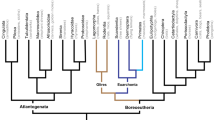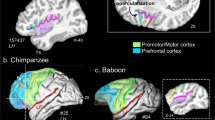Abstract
Some might consider the title of this piece preposterous. Bishop Wilberforce would no doubt have shaken his fist at it, just as he disputed Huxley's championing of darwinian continuity. But the title of this essay is no more outrageous than one entitled ‘The chimpanzee's bird brain’, for there has been extensive evolutionary conservation of many neural and psychological functions across species. We share with chimpanzees some—but not all—mental functions, some of which are shared with other species as well. As the publication of the chimpanzee genome reveals, we also share a good deal of our DNA. Unfortunately, we are virtually in the dark when it comes to understanding how genes build minds. If comparative genomics is to enlighten our understanding of human origins, it must be accompanied by an equally rich description of animal psychology, both in terms of its underlying neural signatures and the evolutionary processes that led to convergence and divergence with other species.
This is a preview of subscription content, access via your institution
Access options
Subscribe to this journal
Receive 51 print issues and online access
$199.00 per year
only $3.90 per issue
Buy this article
- Purchase on Springer Link
- Instant access to full article PDF
Prices may be subject to local taxes which are calculated during checkout



Similar content being viewed by others
References
Hauser, M. D. & Spelke, E. S. in The Cognitive Neurosciences (ed. Gazzaniga, M.) 1025–1147 (MIT Press, Cambridge, 2004)
Spelke, E. Core knowledge. Am. Psychol. 55, 1233–1243 (2000)
Whiten, A. The second inheritance system of chimpanzees and humans. Nature doi:10.1038/nature04023 (this issue)
de Waal, F. B. M. A century of getting to know the chimpanzee. Nature doi:10.1038/nature03999 (this issue)
Butterworth, B. What Counts: How Every Brain is Hardwired for Math (Free Press, New York, 1999)
Carey, S. Evolutionary and ontogenetic foundations of arithmetic. Mind Lang. 16, 37–55 (2001)
Dehaene, S. The Number Sense (Oxford Univ. Press, Oxford, 1997)
Gallistel, C. R. The Organization of Learning (MIT Press, Cambridge, 1990)
Manson, J. H. & Wrangham, R. W. Intergroup aggression in chimpanzees and humans. Curr. Anthropol. 32, 369–390 (1991)
Wrangham, R. W. & Peterson, D. Demonic Males (Houghton Mifflin, New York, 1996)
Wilson, M. L., Hauser, M. D. & Wrangham, R. W. Does participation in cooperative intergroup conflict depend on numerical assessment, range location, or rank for wild chimpanzees? Anim. Behav. 61, 1201–1213 (2001)
Platt, J. R. & Johnson, D. M. Localization of position within a homogeneous behaviour chain: effects of error contingencies. Learn. Motiv. 2, 386–414 (1971)
Beran, M. J. Summation and numerousness judgments of sequentially presented sets of items by chimpanzees (Pan troglodytes). J. Comp. Psychol. 115, 181–191 (2001)
Beran, M. J. & Rumbaugh, D. M. “Constructive” enumeration by chimpanzees (Pan troglodytes) on a computerized task. Anim. Cogn. 4, 81–89 (2001)
Wynn, K. Addition and subtraction by human infants. Nature 358, 749–750 (1992)
Hauser, M. D., MacNeilage, P. & Ware, M. Numerical representations in primates. Proc. Natl Acad. Sci. USA 93, 1514–1517 (1996)
Uller, C., Hauser, M. D. & Carey, S. Spontaneous representation of number in cotton-top tamarins (Saguinus oedipus). J. Comp. Psychol. 115, 248–257 (2001)
Hauser, M. D. & Carey, S. Spontaneous number representations of small numbers of objects by rhesus macaques: examinations of content and format. Cogn. Psychol. 47, 367–401 (2003)
Biro, D. & Matsuzawa, T. Numerical ordering in a chimpanzee (Pan troglodytes): planning, executing, and monitoring. J. Comp. Psychol. 113, 178–195 (1999)
Boysen, S. T. & Bernston, G. G. Numerical competence in a chimpanzee. J. Comp. Psychol. 103, 23–31 (1989)
Brannon, E. M. & Terrace, H. S. Ordering of the numerosities 1 to 9 by monkeys. Science 282, 746–749 (1998)
Kawai, N. & Matsuzawa, T. Numerical memory span in a chimpanzee. Nature 403, 39–40 (2000)
Tomonaga, M. & Matsuzawa, T. Sequential responding to arabic numerals with wild cards by the chimpanzee (Pan troglodytes). Anim. Cogn. 3, 1–11 (2000)
Gelman, R. & Gallistel, C. R. Language and the origin of numerical concepts. Science 306, 441–443 (2004)
Gordon, P. Numerical cognition without words: Evidence from Amazonia. Science 306, 496–499 (2004)
Pica, P., Lemer, C., Izard, V. & Dehaene, S. Exact and approximate arithmetic in an Amazonian indigene group. Science 306, 499–503 (2004)
Hauser, M. D., Chomsky, N. & Fitch, W. T. The faculty of language: What is it, who has it, and how did it evolve? Science 298, 1569–1579 (2002)
Chomsky, N. On Nature and Language (Cambridge Univ. Press, New York, 2000)
Premack, D. & Premack, A. Original Intelligence (McGraw Hill, New York, 2002)
Premack, D. & Woodruff, G. Does the chimpanzee have a theory of mind? Behav. Brain Sci. 4, 515–526 (1978)
Cheney, D. L. & Seyfarth, R. M. How Monkeys See the World: Inside the Mind of Another Species (Chicago Univ. Press, Chicago, 1990)
Hauser, M. D. Wild Minds: What Animals Really Think (Henry Holt, New York, 2000)
Tomasello, M. & Call, J. Primate Cognition (Oxford Univ. Press, Oxford, 1997)
Povinelli, D. J. & Eddy, T. J. What young chimpanzees know about seeing. Monogr. Soc. Res. Child Dev. 247, 1–147 (1996)
Hare, B., Call, J., Agnetta, B. & Tomasello, M. Chimpanzees know what conspecifics do and do not see. Anim. Behav. 59, 771–785 (2000)
Hare, B., Call, J. & Tomasello, M. Do chimpanzees know what conspecifics know? Anim. Behav. 61, 139–151 (2001)
Call, J., Hare, B., Carpenter, M. & Tomasello, M. ‘Unwilling’ versus ‘unable’: chimpanzees' understanding of human intentional action. Dev. Sci. 7, 488–498 (2004)
Hare, B. & Tomasello, M. Chimpanzees are more skilful in competitive than in cooperative cognitive tasks. Anim. Behav. 68, 571–581 (2004)
Flombaum, J. & Santos, L. Rhesus monkeys attribute perceptions to others. Curr. Biol. 15, 1–20 (2005)
Hare, B., Brown, M., Williamson, C. & Tomasello, M. The domestication of social cognition in dogs. Science 298, 1636–1639 (2002)
Emery, N. J. & Clayton, N. S. Effects of experience and social context on prospective caching strategies by scrub jays. Nature 414, 443–446 (2001)
Acknowledgements
For support during the writing of this article, I wish to thank the McDonnell Foundation, the Guggenheim Foundation and a National Science Foundation ROLE grant.
Author information
Authors and Affiliations
Corresponding author
Ethics declarations
Competing interests
Reprints and permissions information is available at npg.nature.com/reprintsandpermissions. The author declares no competing financial interests.
Rights and permissions
About this article
Cite this article
Hauser, M. Our chimpanzee mind. Nature 437, 60–63 (2005). https://doi.org/10.1038/nature03917
Issue Date:
DOI: https://doi.org/10.1038/nature03917
This article is cited by
-
Relative quantity judgments in South American sea lions (Otaria flavescens)
Animal Cognition (2011)
-
Functional homology and homology of function: biological concepts and philosophical consequences
Biology & Philosophy (2007)
-
The second inheritance system of chimpanzees and humans
Nature (2005)
Comments
By submitting a comment you agree to abide by our Terms and Community Guidelines. If you find something abusive or that does not comply with our terms or guidelines please flag it as inappropriate.



